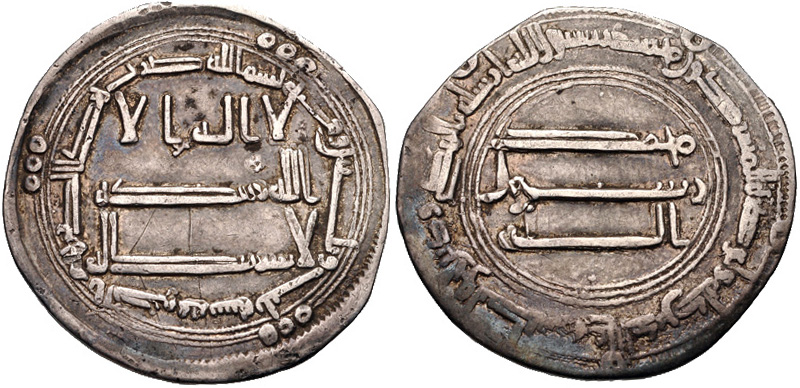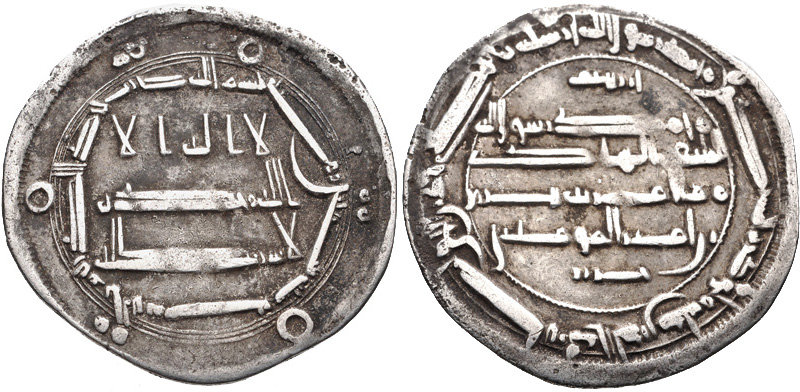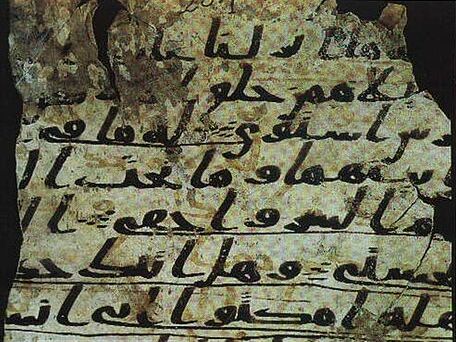|
Abdallah Ibn Ubaydallah Ibn Al-Abbas
Abdallah ibn Ubaydallah ibn al-Abbas al-Hashimi ( ar, عبد الله بن عبيد الله بن العباسي الهاشمي) was a ninth century Abbasid personage and governor of the Yemen. Career A minor member of the Abbasid dynasty, being a second cousin of the caliphs al-Hadi (r. 785–786) and Harun al-Rashid (r. 789–809), Abdallah was appointed governor of the Yemen by al-Ma'mun (r. 813–833), and he arrived in Sana'a in ca. 832. He remained governor until the death of al-Ma'mun in 833, at which point he decided to place Abbad ibn al-Ghamr al-Shihabi in charge of the province and departed for Iraq. Abdallah was also a frequent leader of the pilgrimage A pilgrimage is a journey, often into an unknown or foreign place, where a person goes in search of new or expanded meaning about their self, others, nature, or a higher good, through the experience. It can lead to a personal transformation, aft ..., having led the annual events of 828, 829, 831, and possibly 832.; ... [...More Info...] [...Related Items...] OR: [Wikipedia] [Google] [Baidu] |
Al-Ma'mun
Abu al-Abbas Abdallah ibn Harun al-Rashid ( ar, أبو العباس عبد الله بن هارون الرشيد, Abū al-ʿAbbās ʿAbd Allāh ibn Hārūn ar-Rashīd; 14 September 786 – 9 August 833), better known by his regnal name Al-Ma'mun ( ar, المأمون, al-Maʾmūn), was the seventh Abbasid caliph, who reigned from 813 until his death in 833. He succeeded his half-brother al-Amin after a civil war, during which the cohesion of the Abbasid Caliphate was weakened by rebellions and the rise of local strongmen; much of his domestic reign was consumed in pacification campaigns. Well educated and with a considerable interest in scholarship, al-Ma'mun promoted the Translation Movement, the flowering of learning and the sciences in Baghdad, and the publishing of al-Khwarizmi's book now known as "Algebra". He is also known for supporting the doctrine of Mu'tazilism and for imprisoning Imam Ahmad ibn Hanbal, the rise of religious persecution ('' mihna''), and for the resum ... [...More Info...] [...Related Items...] OR: [Wikipedia] [Google] [Baidu] |
Ishaq Ibn Al-Abbas Ibn Muhammad Al-Hashimi
Ishaq ibn al-Abbas ibn Muhammad al-Hashimi ( ar, إسحاق بن العباس بن محمد الهاشمي) was a ninth century Abbasid personage, provincial governor and military commander. He was twice appointed as governor of the Yemen, in 824 and 830. Career Ishaq was a minor member of the Abbasid dynasty, being a nephew of the caliphs al-Saffah (r. 750–754) and al-Mansur (r. 754–775). He is mentioned as being in Iraq in 817, when he played a small role in supporting the anti-caliph Ibrahim ibn al-Mahdi. In 824 Ishaq was appointed governor of the Yemen for the caliph al-Ma'mun (r. 813–833), and he arrived in Sana'a at the end of that year. His governorship of the province proved to be extremely tumultuous, and he was soon accused of treating the Yemenis in a harsh manner. Affairs in the province eventually became so disorderly that al-Ma'mun decided to dismiss Ishaq, and Muhammad ibn Nafi' was appointed as governor in his place. In 830, Ishaq was selected to lead th ... [...More Info...] [...Related Items...] OR: [Wikipedia] [Google] [Baidu] |
Abbad Ibn Al-Ghamr Al-Shihabi
Abbad ibn al-Ghamr al-Shihabi ( ar, عباد بن الغمر الشهابي; also known as Abbad ibn Umar) was a ninth century governor of the Yemen for the Abbasid Caliphate. A local Yemeni chief, Abbad was placed in charge of Sana'a by Muhammad ibn Abdallah ibn Muhriz in 824, and he held power there until the arrival of the governor Ishaq ibn al-Abbas ibn Muhammad al-Hashimi at the end of the year. Following the death of the caliph al-Ma'mun in 833, Abbad was again appointed over the Yemen by Abdallah ibn Ubaydallah ibn al-Abbas, and he was confirmed as governor by the new caliph al-Mu'tasim Abū Isḥāq Muḥammad ibn Hārūn al-Rashīd ( ar, أبو إسحاق محمد بن هارون الرشيد; October 796 – 5 January 842), better known by his regnal name al-Muʿtaṣim biʾllāh (, ), was the eighth Abbasid caliph, ruling f ... (r. 833–842). He remained in the governorship until the end of 835, when he was replaced by Abd al-Rahim ibn Ja'far ibn Sulayman al-Hashi ... [...More Info...] [...Related Items...] OR: [Wikipedia] [Google] [Baidu] |
Abbasid
The Abbasid Caliphate ( or ; ar, الْخِلَافَةُ الْعَبَّاسِيَّة, ') was the third caliphate to succeed the Islamic prophet Muhammad. It was founded by a dynasty descended from Muhammad's uncle, Abbas ibn Abdul-Muttalib (566–653 CE), from whom the dynasty takes its name. They ruled as caliphs for most of the caliphate from their capital in Baghdad in modern-day Iraq, after having overthrown the Umayyad Caliphate in the Abbasid Revolution of 750 CE (132 anno Hegirae, AH). The Abbasid Caliphate first centered its government in Kufa, modern-day Iraq, but in 762 the caliph Al-Mansur founded the city of Baghdad, near the ancient Babylonian Empire, Babylonian capital city of Babylon. Baghdad became the center of Science in the medieval Islamic world, science, Islamic culture, culture and List of inventions in the medieval Islamic world, invention in what became known as the Islamic Golden Age, Golden Age of Islam. This, in addition to housing several ke ... [...More Info...] [...Related Items...] OR: [Wikipedia] [Google] [Baidu] |
Yemen
Yemen (; ar, ٱلْيَمَن, al-Yaman), officially the Republic of Yemen,, ) is a country in Western Asia. It is situated on the southern end of the Arabian Peninsula, and borders Saudi Arabia to the Saudi Arabia–Yemen border, north and Oman to the Oman–Yemen border, northeast and shares maritime borders with Eritrea, Djibouti, and Somalia. Yemen is the second-largest Arabs, Arab sovereign state in the peninsula, occupying , with a coastline stretching about . Its constitutionally stated Capital city, capital, and largest city, is Sanaa. As of 2021, Yemen has an estimated population of some 30.4 million. In ancient times, Yemen was the home of the Sabaeans, a trading state that included parts of modern-day Ethiopia and Eritrea. Later in 275 AD, the Himyarite Kingdom was influenced by Judaism. Christianity arrived in the fourth century. Islam spread quickly in the seventh century and Yemenite troops were crucial in the early Islamic conquests. Several Dynasty, dynasties ... [...More Info...] [...Related Items...] OR: [Wikipedia] [Google] [Baidu] |
Al-Hadi
Abū Muḥammad Mūsā ibn al-Mahdī al-Hādī ( ar, أبو محمد موسى بن المهدي الهادي; 26 April 764 CE 14 September 786 CE) better known by his laqab Al-Hādī (الهادي) was the fourth Arab Abbasid caliph who succeeded his father Al-Mahdi and ruled from 169 AH (785 CE) until his death in 170 AH (786 CE). His short reign ended with internal chaos and power struggles with his mother. Biography Al-Hadi was the eldest son of Al-Mahdi and Al-Khayzuran and the older brother of Harun al-Rashid. He was very dear to his father and was appointed as the first crown prince by his father at the age of 16 and was chosen as the leader of the army. Prior to his death, Al-Mahdi supposedly favored his second son, Harun al-Rashid, as his successor, taking him on multiple military expeditions in 779 and 781 to train him to be the next caliph, as his own father prepared him, but died before the formal transfer of the crown prince title could occur. Alternatively, Al-R ... [...More Info...] [...Related Items...] OR: [Wikipedia] [Google] [Baidu] |
Harun Al-Rashid
Abu Ja'far Harun ibn Muhammad al-Mahdi ( ar , أبو جعفر هارون ابن محمد المهدي) or Harun ibn al-Mahdi (; or 766 – 24 March 809), famously known as Harun al-Rashid ( ar, هَارُون الرَشِيد, translit=Hārūn al-Rashīd) was the fifth Abbasid caliph of the Abbasid Caliphate, reigning from September 786 until his death. His reign is traditionally regarded to be the beginning of the Islamic Golden Age. His epithet "al-Rashid" translates to "the Orthodox", "the Just", "the Upright", or "the Rightly-Guided". Harun established the legendary library Bayt al-Hikma ("House of Wisdom") in Baghdad in present-day Iraq, and during his rule Baghdad began to flourish as a world center of knowledge, culture and trade. During his rule, the family of Barmakids, which played a deciding role in establishing the Abbasid Caliphate, declined gradually. In 796, he moved his court and government to Raqqa in present-day Syria. A Frankish mission came to offer H ... [...More Info...] [...Related Items...] OR: [Wikipedia] [Google] [Baidu] |
Sana'a
Sanaa ( ar, صَنْعَاء, ' , Yemeni Arabic: ; Old South Arabian: 𐩮𐩬𐩲𐩥 ''Ṣnʿw''), also spelled Sana'a or Sana, is the capital and largest city in Yemen and the centre of Sanaa Governorate. The city is not part of the Governorate, but forms the separate administrative district of "ʾAmānat al-ʿĀṣima" (). Under the Yemeni constitution, Sanaa is the capital of the country, although the seat of the Yemeni government moved to Aden, the former capital of South Yemen in the aftermath of the Houthi occupation. Aden was declared as the temporary capital by President Abdrabbuh Mansur Hadi in March 2015. At an elevation of , Sanaa is one of the highest capital cities in the world and is next to the Sarawat Mountains of Jabal An-Nabi Shu'ayb and Jabal Tiyal, considered to be the highest mountains in the country and amongst the highest in the region. Sanaa has a population of approximately 3,937,500 (2012), making it Yemen's largest city. As of 2020, the greater ... [...More Info...] [...Related Items...] OR: [Wikipedia] [Google] [Baidu] |
Iraq
Iraq,; ku, عێراق, translit=Êraq officially the Republic of Iraq, '; ku, کۆماری عێراق, translit=Komarî Êraq is a country in Western Asia. It is bordered by Turkey to Iraq–Turkey border, the north, Iran to Iran–Iraq border, the east, the Persian Gulf and Kuwait to the southeast, Saudi Arabia to the south, Jordan to Iraq–Jordan border, the southwest and Syria to Iraq–Syria border, the west. The Capital city, capital and largest city is Baghdad. Iraq is home to diverse ethnic groups including Iraqi Arabs, Kurds, Iraqi Turkmen, Turkmens, Assyrian people, Assyrians, Armenians in Iraq, Armenians, Yazidis, Mandaeans, Iranians in Iraq, Persians and Shabaks, Shabakis with similarly diverse Geography of Iraq, geography and Wildlife of Iraq, wildlife. The vast majority of the country's 44 million residents are Muslims – the notable other faiths are Christianity in Iraq, Christianity, Yazidism, Mandaeism, Yarsanism and Zoroastrianism. The official langu ... [...More Info...] [...Related Items...] OR: [Wikipedia] [Google] [Baidu] |
Hajj
The Hajj (; ar, حَجّ '; sometimes also spelled Hadj, Hadji or Haj in English) is an annual Islamic pilgrimage to Mecca, Saudi Arabia, the holiest city for Muslims. Hajj is a mandatory religious duty for Muslims that must be carried out at least once in their lifetime by all adult Muslims who are physically and financially capable of undertaking the journey, and of supporting their family during their absence from home. In Islamic terminology, Hajj is a pilgrimage made to the Kaaba, the "House of God", in the sacred city of Mecca in Saudi Arabia. It is one of the Five Pillars of Islam, alongside Shahadah (oath to God), Salat (prayer), Zakat (almsgiving) and Sawm (fasting of Ramadan). The Hajj is a demonstration of the solidarity of the Muslim people, and their submission to God ( Allah). The word Hajj means "to attend a journey", which connotes both the outward act of a journey and the inward act of intentions. The rites of pilgrimage are performed over five to six ... [...More Info...] [...Related Items...] OR: [Wikipedia] [Google] [Baidu] |
9th-century People From The Abbasid Caliphate
The 9th century was a period from 801 ( DCCCI) through 900 ( CM) in accordance with the Julian calendar. The Carolingian Renaissance and the Viking raids occurred within this period. In the Middle East, the House of Wisdom was founded in Abbasid Baghdad, attracting many scholars to the city. The field of algebra was founded by the Muslim polymath al-Khwarizmi. The most famous Islamic Scholar Ahmad ibn Hanbal was tortured and imprisoned by Abbasid official Ahmad ibn Abi Du'ad during the reign of Abbasid caliph al-Mu'tasim and caliph al-Wathiq. In Southeast Asia, the height of the Mataram Kingdom happened in this century, while Burma would see the establishment of the major kingdom of Pagan. Tang China started the century with the effective rule under Emperor Xianzong and ended the century with the Huang Chao rebellions. While the Maya experienced widespread political collapse in the central Maya region, resulting in internecine warfare, the abandonment of cities, and a northward ... [...More Info...] [...Related Items...] OR: [Wikipedia] [Google] [Baidu] |

.jpg)




